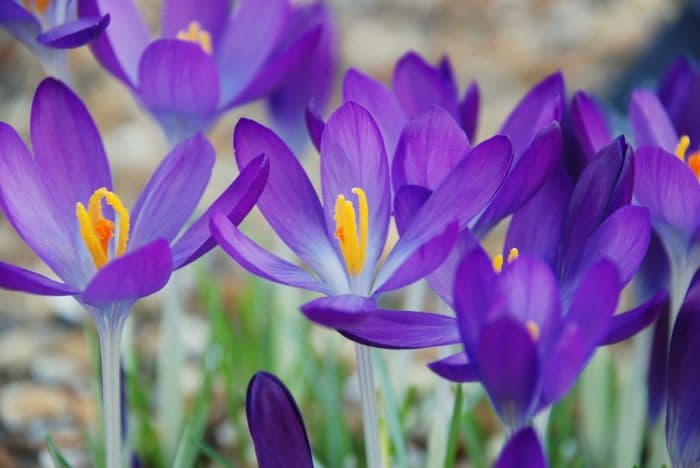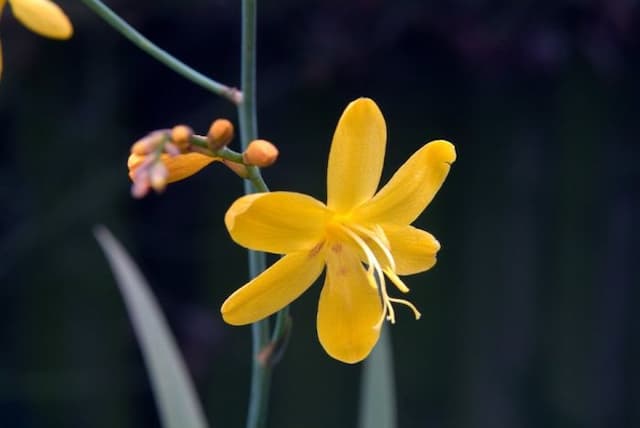Early Crocus Crocus tommasinianus 'Whitewell Purple'

ABOUT
Crocus tommasinianus 'Whitewell Purple', also known as the early crocus, showcases delicate cup-shaped flowers that exhibit a captivating shade of light purple, often with a silken, almost iridescent sheen. These blooms are distinct for their slender, elongated petals that harmonize to create a gentle, yet eye-catching floral display. Amidst its flowers, one can observe contrasting bright orange stamen in the center, adding a spark of vibrant color that stands out against the cooler tones of the petals. The narrow, grass-like foliage of the early crocus emerges parallel to the flowers, displaying a rich green color with a silvery stripe running down the middle, which gives the plant an overall graceful and slender appearance. This foliage sometimes emerges with a twist or a delicate curl, enhancing the plant's whimsical charm. As part of the heralds of spring, the early crocus 'Whitewell Purple' can often be spotted peeking through the last remnants of snow or winter mulch, signaling the upcoming change of seasons with its colorful blossoms.
About this plant
 Names
NamesFamily
Iridaceae
Synonyms
Early Crocus, Tommasini's Crocus, Woodland Crocus
Common names
Crocus tommasinianus 'Whitewell Purple'.
 Toxicity
ToxicityTo humans
Crocus tommasinianus, commonly known as the Woodland Crocus, is not typically considered toxic to humans. However, it is important to note that much of the information available about crocus plants focuses on the more widely recognized Autumn Crocus, which is toxic due to its colchicine content. The Woodland Crocus is a different species and does not contain this toxic compound. If ingested in large quantities, any plant material could cause stomach upset or an allergic reaction, but significant poisoning from Woodland Crocus is unlikely. Always exercise caution and prevent children from eating any plant material.
To pets
The Woodland Crocus, known botanically as Crocus tommasinianus 'Whitewell Purple', is generally not toxic to pets. Unlike its relative, the Autumn Crocus, which contains highly toxic compounds like colchicine, the Woodland Crocus is not known to have the same level of toxicity. However, gastrointestinal upset is a common response in animals if they consume a large amount of any non-food plant. It is always safest to prevent pets from eating plants as individual animals might have sensitivities or allergic reactions.
 Characteristics
CharacteristicsLife cycle
Perennials
Foliage type
Deciduous
Color of leaves
Green
Flower color
Purple
Height
3-6 inches (7.5-15 cm)
Spread
1-3 inches (2.5-7.5 cm)
Plant type
Bulb
Hardiness zones
3-8
Native area
Balkans
Benefits
 General Benefits
General Benefits- Early Bloom: Provides color and visual interest in late winter or early spring when few other plants are flowering.
- Ecosystem Support: Offers essential nectar to pollinators such as bees when other food sources are scarce.
- Low Maintenance: Requires minimal care once established, making it suitable for busy gardeners or naturalized areas.
- Naturalizing: Propagates itself over time, leading to a denser and more expansive display without additional planting.
- Drought Tolerance: Once established, it is relatively tolerant to dry conditions, reducing the need for frequent watering.
- Cold Hardy: Can withstand cold climates and is perfect for temperate regions that experience freezing winters.
- Deer and Rodent Resistance: Typically resistant to deer and rodents, minimizing plant damage from wildlife.
- Compact Size: With its small stature, it's well-suited to rock gardens or border fronts without overshadowing other plants.
 Medical Properties
Medical PropertiesThis plant is not used for medical purposes.
 Air-purifying Qualities
Air-purifying QualitiesThis plant is not specifically known for air purifying qualities.
 Other Uses
Other Uses- Crocus tommasinianus bulbs can be a food source for squirrels and small rodents, who may dig them up and eat them during the winter months.
- The blooms of Crocus tommasinianus can be a valuable early spring nectar source for bees and other pollinating insects when not many other plants are in flower.
- Dried Crocus tommasinianus petals have been used in crafts such as floral arrangements and potpourri, adding color and interest.
- In photography and painting, Crocus tommasinianus can be used as a subject to represent early spring and the concept of rebirth and new beginnings.
- Gardeners may use the Crocus tommasinianus as a timing cue for spring gardening activities, as their emergence indicates that the soil is thawing.
- These plants can be used in children's educational projects to teach about plant life cycles, especially bulb growth and development.
- In the culinary realm, while not commonly eaten, the flowers could be used as a garnish for spring-themed dishes, adding a splash of purple.
- Due to their early blooming, they can be part of climate study observations helping track the effects of climate change on flowering times.
- Crocus tommasinianus can be used in landscaping to create a 'lawn river' effect where the flowers naturalize and create the appearance of a flowing river of purple in the grass.
- Their strong purplish hue can inspire artists and designers in their color palettes, informing creative projects from fashion to interior design.
Interesting Facts
 Feng Shui
Feng ShuiThe Crocus is not used in Feng Shui practice.
 Zodiac Sign Compitability
Zodiac Sign CompitabilityThe Crocus is not used in astrology practice.
 Plant Symbolism
Plant Symbolism- Hope: As one of the first flowers to bloom in spring, crocuses like Crocus tommasinianus symbolize hope and the anticipation for the coming of warmer seasons.
- Youthful Gladness: Their delicate and cheerful flowers are evocative of the joy and exuberance of youth.
- Cheerfulness: The bright color of 'Whitewell Purple' crocus uplifts the spirit, symbolizing cheer and good moods.
- Rebirth: As spring bloomers, crocuses signify rebirth and new beginnings, embodying the cycle of nature's reawakening.
 Water
WaterEarly crocus, including the 'Whitewell Purple' variety, requires moderate watering during its growing season in the spring, especially if rainfall is minimal. It's important to keep the soil moderately moist but not waterlogged. Typically, watering once a week with about half a gallon per square yard should suffice, but this can vary depending on soil type and local weather conditions. Once the foliage begins to die back after blooming, reduce watering as the corms enter dormancy. Overwatering during dormancy can lead to rot, so it's crucial to allow the soil to dry out between waterings.
 Light
LightEarly crocus, like 'Whitewell Purple', prefers full sun to partial shade. An ideal location would provide at least six hours of direct sunlight daily; however, they will tolerate some light shade, especially in hotter regions. They thrive under deciduous trees that provide sunlight in the spring before the leaves fully emerge, giving them the light they need during their active growing season.
 Temperature
TemperatureThe early crocus 'Whitewell Purple' can tolerate a wide range of temperatures and is cold-hardy. It thrives in temperatures typical of early spring, between 35 and 65 degrees Fahrenheit. The crocus corms can survive winter cold down to -20 degrees Fahrenheit, which makes them suitable for fall planting in many regions.
 Pruning
PruningThe early crocus 'Whitewell Purple' does not require traditional pruning, but spent flowers can be removed to maintain a tidy appearance. It's generally best to leave the foliage in place until it dies back naturally to allow the corms to gather energy for the next growing season. Cutting back foliage should only occur when it has completely yellowed, typically several weeks after blooming has finished.
 Cleaning
CleaningAs needed
 Soil
SoilEarly Crocus thrives in well-draining, rich in organic matter soil with a pH range of 6.0 to 7.0. The best soil mix for Early Crocus would be a combination of loamy garden soil, compost, and sand to ensure proper drainage. It is essential to avoid waterlogged conditions which can lead to bulb rot.
 Repotting
RepottingEarly Crocus bulbs should be lifted and divided every 3 to 4 years to prevent overcrowding. This ensures continued vigor and bloom. Repotting should be done after the foliage has died back in late spring or early summer.
 Humidity & Misting
Humidity & MistingEarly Crocus does not require high humidity and can tolerate the natural humidity found in most outdoor garden environments. It is well-suited to temperate climates and doesn't need specific humidity adjustments when grown outside.
 Suitable locations
Suitable locationsIndoor
Place in bright, indirect light and cool temps.
Outdoor
Plant in well-draining soil in full sun.
Hardiness zone
3-8 USDA
 Life cycle
Life cycleCrocus tommasinianus 'Whitewell Purple', commonly known as the Woodland Crocus, begins its life cycle as a corm, a storage organ that survives underground during dormancy. In late winter to early spring, spurred by the warming soil temperatures, it germinates and sends up narrow, grass-like leaves along with slender flower stalks bearing purple flowers. After pollination, typically by bees attracted to its bright colors and early nectar, the flowers produce seed capsules. Once the flowers have faded, the plant focuses on photosynthesis and the storage of energy in the corm for the next season. By late spring, the foliage dies back and the plant enters a period of dormancy through the summer and fall. The cycle resumes the following spring, with the corm producing a new set of leaves and flowers.
 Propogation
PropogationPropogation time
Spring
The most popular method of propagation for Crocus tommasinianus 'Whitewell Purple', commonly known as the Early Crocus, is by dividing its bulbs, also known as corms. This process is typically done in the late summer, after the foliage has died back, and the plant is dormant. Gardeners should carefully dig up the bulbs and gently separate any offsets, which are the smaller bulbs that form around the base of the mother bulb. These offsets can be replanted immediately at a depth of about 3 to 4 inches (approximately 7.5 to 10 centimeters) in well-draining soil, with the pointed end facing upward. It's important to space the bulbs around 3 inches (about 7.5 centimeters) apart to allow for proper growth and ensure they receive full to partial sunlight.









